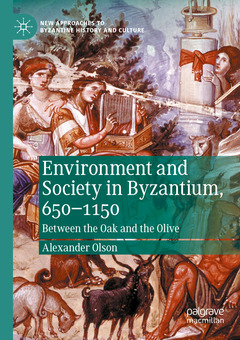Description
Environment and Society in Byzantium, 650-1150, 1st ed. 2020
Between the Oak and the Olive
New Approaches to Byzantine History and Culture Series
Author: Olson Alexander
Language: English
Environment and Society in Byzantium, 650-1150
Publication date: 11-2021
258 p. · 14.8x21 cm · Paperback
Publication date: 11-2021
258 p. · 14.8x21 cm · Paperback
Environment and Society in Byzantium, 650-1150
Publication date: 11-2020
258 p. · 14.8x21 cm · Hardback
Publication date: 11-2020
258 p. · 14.8x21 cm · Hardback
Description
/li>Contents
/li>Biography
/li>Comment
/li>
This book illuminates Byzantines' relationship with woodland between the seventh and twelfth centuries. Using the oak and the olive as objects of study, this work explores shifting economic strategies, environmental change, and the transformation of material culture throughout the middle Byzantine period. Drawing from texts, environmental data, and archaeological surveys, this book demonstrates that woodland's makeup was altered after Byzantium's seventh-century metamorphosis, and that people interacted in new ways with this re-worked ecology. Oak obtained prominence after late antiquity, illustrating the shift from that earlier era's intensive agriculture to a more sylvan middle Byzantine economy. Meanwhile, the olive faded into the background, re-emerging in the eleventh and twelfth centuries thanks to the initiative of people adapting yet again to newly changed political and economic circumstances. This book therefore shows that Byzantines' relationship with their ecology was far from static, and that Byzantines' decisions had environmental impacts.
1. Introduction
2. Middle Byzantium's Environmental and Economic Antecedents
2.1 Taxes and Rents, Olives and Vines, Slaves and Cattle
2.2 A Transformed Economy, Culture, and Environment
2.3 An Elite-less Landscape?2.4 A New Equilibrium?
3. An Evergreen Empire
3.1 Woodland Species Around the Aegean
3.2 The Expansion of Woodland in the Aegean Littoral
3.3 Contexts for Woodland Species’ Success
3.4 Using Woodland
4. The Decline of the Olive in Middle Byzantium
4.1 What the Olive Tree Does and How People Work with it
4.2 The Olive in the Ancient and Modern Contexts
4.3 The Olive in Retreat
4.4 Where did the Olives go?
4.5 New Uses for an Old Object
5. Re-arranging Woods and Scrub
5.1 Complicating the Landscape
5.2 Contexts for Altering the Landscape
5.3 Deciduous Oak’s Fortunes
5.4 Chestnut's Fortunes
5.5 Room to Maneuver
6. The Return of the Olive
6.1 Where and When the Olive Returns
6.2 Monastic Assistance
6.3 From Peasants to Merchants
6.4 Olives from the Scrub
7. The Devil Chops Wood
7.1 Social Causes and Outcomes of a Contested Countryside
7.2 Hagiography and Conflict in the Landscape
7.3 Hagiographical Strategies for a Contested Landscape
8. Conclusion
Alexander Olson received a Ph.D. at the University of Wisconsin, USA where he studied Byzantine and environmental history. He now enjoys working as a bureaucrat.
Illuminates Byzantines' relationship with woodland between the seventh and twelfth centuries
Explores shifting economic strategies, environmental change, and the transformation of material culture throughout the middle Byzantine period
Argues that Byzantines' relationship with their ecology was far from static, and that Byzantines' decisions had environmental impacts
© 2024 LAVOISIER S.A.S.




